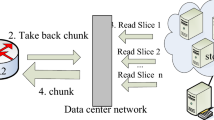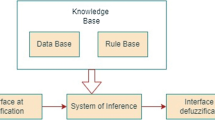Abstract
By using the traditional active E2E (end-to-end) detection method to locate the congested link in IP network, we can only judge whether the network is congestion or not, and the congested cause cannot be effectively known. However, the passive detection method needs to acquire the syslog of all routers in the managed network, which requires a large amount of data. In this paper, a kind of multimodal spatiotemporal correlation fuzzy inference method for network health monitoring method was proposed through combining with the method of active E2E detection and passive detection. First, the set of network-congested links is obtained based on the Bayesian theorem through E2E path performance detection; then, the router syslog associated with the congested links will be acquired for a period of time, and the abnormal events in the syslog are detected based on the principle of mutual information (MI), so as to find the causes of network congestion. Based on the multimodal spatiotemporal correlation fuzzy paradigms combining with the active end-to-end detection and passive detection technology, the amount of data analysis will be greatly reduced and the operation speed will be improved. Simulation experiments and actual experiments verified the accuracy of the method this paper proposed.






Similar content being viewed by others
Abbreviations
- MI:
-
Mutual information
- IP:
-
Internet Protocol
- E2E:
-
End to end
- SNMP:
-
Simple Network Management Protocol
- PCA:
-
Principal component analysis
- SCP:
-
Set coverage problem
- MAP:
-
Maximum A-posterior probability
- ARPP:
-
Agreement Rate of Path Properties
References
Luo-ming M (2003) Network management problems progress and prospect. J Beijing Univ Posts Telecommun 26(2):1–8
Qiu T, Ge Z, Pei D, Wang J, Xu J (2010) What happened in my network: mining network events from router syslogs. Proceedings of the 10th ACM SIGCOMM Conference on Internet Measurement 2010 (IMC’10), ACM, Melbourne, Australia, 1-3 November, 472–484
Steinder M, Sethi AS (2004) Probabilistic fault diagnosis in communication systems through incremental hypothesis updating. Comput Netw 45(4):537–562
Kandula S, Katabi D, Vasseur JP (2005) Shrink: a tool for failure diagnosis in IP networks. Proceedings of the ACM Workshop on Mining Network Data, Minenet 2005, ACM, Philadelphia, Pennsylvania, USA, 22-26 August, 173–178
Kompella RR, Yates J, Greenberg A, Snoeren AC (2007) Detection and localization of network black holes. Proceedings of the Computer Communications (INFOCOM 2007), IEEE, Barcelona, Spain, 6-12 May, 2180–2188
Duffield N (2006) Network tomography of binary network performance characteristics. IEEE Trans Inf Theory 52(12):5373–5388
Batsakis A, Malik T, Terzis A (2005) Practical Passive Lossy Link Inference Proceedings of Passive and Active Network Measurement, International Workshop (PAM 2005). Springer-Verlag Berlin Heidelberg, Boston, Ma, USA 31 March - 1 April, 362–367
Padmanabhan VN, Qiu LL, Wang HJ. (2002). Server-based inference of internet performance. Microsoft Corporation, One Microsoft Way Redmond, WA 98052
Nguyen HX, Thiran P (2007) The Boolean solution to the congested IP link location problem: theory and practice. Proceedings of the 26th IEEE International Conference on Computer Communications (INFOCOM 2007), IEEE, Barcelona, Spain, 6–12 May, 2117–2125
Salehi M, Namdari F (2018) Fault location on branched networks using mathematical morphology. IET Gener Transm Distrib 12(1):207–216
Majidi M, Etezadi-Amoli M (2017) A new fault location technique in smart distribution networks using synchronized/non-synchronized measurements. IEEE Trans Power Delivery 99:1–1
Splunk. http://www.splunk.com/
Yamanishi K, Maruyama M (2005) Dynamic syslog mining for network failure monitoring. In: Proc. of KDD
Kompella RR, Yates J, Greenberg A et al (2005) IP fault localization via risk modeling. Acm/usenix NSDI:57–70
Kandula S, Katabi D, Vasseur JP (2005) Shrink: a tool for failure diagnosis in IP networks. In: ACM SIGCOMM Workshop on Mining Network Data ACM, pp 173–178
Wang T, Srivatsa M, Agrawal D et al (2009) Learning, indexing, and diagnosing network faults. In: ACM SIGKDD International Conference on Knowledge Discovery and Data Mining. ACM, pp 857–866
Xu W, Huang L, Fox A et al (2009) Detecting large-scale system problems by mining console logs. In: ACM Sigops, Symposium on Operating Systems Principles. ACM, pp 117–132
Vaarandi R, Podiņš K (2011) Network IDS alert classification with frequent itemset mining and data clustering. In: International Conference on Network and Service Management IEEE, pp 451–456
Kimura T, Ishibashi K, Mori T et al (2014) Spatio-temporal factorization of log data for understanding network events. In: IEEE INFOCOM 2014 - IEEE Conference on Computer Communications. IEEE, pp 610–618
Shavitt Y, Sun X, Wool A, Yener B (2003) Computing the unmeasured: an algebraic approach to internet mapping. IEEE J Sel Areas Commun 22(1):67–78
Chen Y, Wen XL, Duan ZM, Li YC (2017) Algorithm for large scale IP network multiple link congestion inference. Ruan Jian Xue Bao/Journal of Software 28(7):1815–1834
Kochjanusz M, Ringel Z (2018) Mutual information, neural networks and the renormalization group. Nat Phys 14:578–582
Wan C, Yan X, Zhang D, Qu Z, Yang Z (2019) An advanced fuzzy Bayesian-based FMEA approach for assessing maritime supply chain risks. Transport Res Part E: Log Transport Rev 125:222–240
Funding
This study was supported by the Key Scientific Research Projects of Henan Colleges and Universities in 2018. (No. 18A510019), and the Science and Technology Development Program Project of Henan Province (No. 192102210109).
Author information
Authors and Affiliations
Corresponding author
Ethics declarations
Competing interest
The authors declare that they have no conflict of interest.
Additional information
Publisher’s note
Springer Nature remains neutral with regard to jurisdictional claims in published maps and institutional affiliations.
Rights and permissions
About this article
Cite this article
Chen, Y., Wen, X., Chou, J. et al. Network health monitoring method based on multimodal spatiotemporal correlation fuzzy inference. Pers Ubiquit Comput 27, 1977–1990 (2023). https://doi.org/10.1007/s00779-019-01263-8
Received:
Accepted:
Published:
Issue Date:
DOI: https://doi.org/10.1007/s00779-019-01263-8




